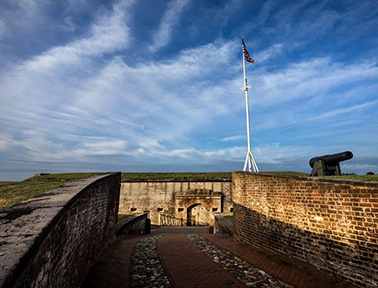Howard DuBose
Happy anniversary to NC State Parks, and you can help them celebrate by visiting some of the oldest parks offering more than recreation opportunities like camping. Happy camping!
Our very first State Park was Mount Mitchell (1916), which is famous for being the tallest mountain (6,684 feet) in the eastern half of the US. It was famous for me because it is the starting point of several very nice kayaking rivers and creeks, and has a number of good, cheap campgrounds around it. And there are a number of other reasons to visit.
One is there are several interesting hiking trails begin or terminate at the top. There are two “tourist” trails—a short nature trail around the top and a short trail to the observation deck. Several of these allow a wilderness backpack camping experience.
One, the Deep Gap Trail, goes down the ridges, peaks of the Black Mountains, and ends at Deep Gap. It is pretty rugged. Another, the Mount Mitchell Trail, starts at Black Mountain Campground and leads eventually to the top of Mt. Mitchell. This one is also rugged, and is the main trail in the area.
Another reason for appreciating Mt. Mitchell is the fully equipped Education Center and Museum, where school classes can study the mountain and its ecology, and visitors can see exhibits showing the history of the Black Mountains area, and its tallest peak, Mt. Mitchell. There is a great warm-weather restaurant on the top, nearly, and 40 picnic sites with grills and tables, as well as two shelters that can be reserved.
Another reason is camping. Though the park is mainly for day visitors, and is closed to most during the winter, there are 9 tent camping sites on top with grill and picnic table, open from May 1through Oct. 31. There are warm weather restrooms nearby, but no showers or hot water.
The best reason, really, for day trippers to visit Mt. Mitchell is the view. On a clear day, it is about the best mountain view in the state. You get the majestic Black Mountains to the north and west, including the second highest peak in the East, Mt. Craig, to the west and southwest, you see the Great Smokey Mountains, and the south and southeast opens up on the Piedmont plateau.
Be sure to always dress appropriately for a high mountain area, and follow black bear warnings.
Our second oldest State Park in North Carolina is completely different. It is Fort Macon, which joined up decades ago. Just about from the highest park to the lowest. Ft. Macon is a Civil War site in Atlantic Beach. It has no camping, so it is a day trip park only, but one with plenty of history, in a beautiful part of NC.
FORT MACON STATE PARK
Fort Macon SP, at the eastern end of Bogue Banks on the Crystal Coast, was part of a string of coastal defense forts, begun after the War of 1812. Work began in 1826 and was briefly worked on by Robert E. Lee as a young engineer. It was recaptured by Union forces early in the Civil War.
The last time it was used for defense was during WW2, well after it became a State Park in 1936. A visit to Fort Macon is popular with history buffs.
And there are other things! There are tours of the restored fort, both guided weekdays at 11 a.m.mid April to end of October) and self-led, plus musket firing demonstrations. There is an Education Center for school classes. Visiting Fort Macon provides an educational experience.
Hours are 9-5 daily. Admission and parking are free. It’s is second only to Jordan Lake State Rec area in number of visitors (1.253 million) last year.
Fort Macon also has short nature trails, birding opportunities (300+ species), surf fishing, swim beach with lifeguards from Memorial Day to Labor Day and picnicking with tables and grills.
Nearby is the Theodore Roosevelt State Natural Area, only 8 miles down NC 58at Pine Knoll Shores. The 265-acres include a N.C. Aquarium and a natural area protects the barrier island’s only remaining maritime forest.

Nature boardwalk on marshy sound-side behind N.C. Aquarium at Pine Knoll Shores at Theodore Roosevelt State Natural Area, but admission to aquarium is needed for access. A nearby 1.5 mile nature trail is available daily to the public. N.C. AQUARIUM PHOTO
The property was given to state in 1971 by Roosevelt’s grandchildren as a living memorial to the 26th president’s dedication to conservation and is managed jointly by the aquarium and Fort Macon SP.
There are two nature trails. The half-mile Alice Hoffman Nature Trail begins on the aquarium’s marsh boardwalk, and aquarium admission is required to use it. The trail starts off from the Coastal Plains Gallery’s Marsh Boardwalk, and crosses a pond and by marsh lands, with plenty of birding and ecology watching and photo opportunities.
The Roosevelt Nature Trail is 1.5 miles and is accessed from west end of the aquarium’s parking lot, and aquarium admission is not required. The out and back trail transverses a dune ridge, through an old growth maritime forest and takes hikers by sound-side and interior marshes.
Last, but not least on our “First 3 State Parks Tour” is Morrow Mountain State Park, which became a park in 1935. Morrow Mountain is located on the beautiful Yadkin River, just NW of Charlotte, and pretty close to Asheboro and the NC Zoological Park.


